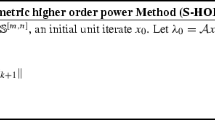Abstract
Tensor is a hot topic in the past decade and eigenvalue problems of higher order tensors become more and more important in the numerical multilinear algebra. Several methods for finding the Z-eigenvalues and generalized eigenvalues of symmetric tensors have been given. However, the convergence of these methods when the tensor is not symmetric but weakly symmetric is not assured. In this paper, we give two convergent gradient projection methods for computing some generalized eigenvalues of weakly symmetric tensors. The gradient projection method with Armijo step-size rule (AGP) can be viewed as a modification of the GEAP method. The spectral gradient projection method which is born from the combination of the BB method with the gradient projection method is superior to the GEAP, AG and AGP methods. We also make comparisons among the four methods. Some competitive numerical results are reported at the end of this paper.
Similar content being viewed by others
References
Bader, B.W., Kolda, T.G., et al.: Matlab tensor toolbox version 2.6, (Feb 2015). http://www.sandia.gov/~tgkolda/TensorToolbox/
Barzilai, J., Borwein, J.M.: Two-point step size gradient methods. IMA J. Numer. Anal. 8, 141–148 (1988)
Bertsekas, D.P.: On the Goldstein-Levitin-Polyak gradient projection method. IEEE Trans. Autom. Control 21, 174–184 (1976)
Bertsekas, D.P., Tsitsiklis, J.N.: Parallel and Distributed Computation: Numerical Methods. Prentice-Hall, Englewood Cliffs, NJ (1989)
Bertsekas, D.P.: Nonlinear Programming, 2nd edn. Athena Scientific, Belmont (1999)
Bi, Y., Liu, X.: A new nonmonotone spectral projected gradient method for bound constrained optimization. Math. Numer. Sin. 35, 419–430 (2013)
Birgin, E.G., Martinez, J.M., Raydan, M.: Nonmonotone spectral projected gradient methods on convex sets. SIAM J. Optim. 10, 1196–1211 (2000)
Birgin, E.G., Martínez, J. M., Raydan, M.: Spectral projected gradient methods: review and perspectives, J. Stat. Softw., 60 (2014). http://www.jstatsoft.org/
Cartwright, D., Sturmfels, B.: The number of eigenvalues of a tensor. Linear Algebra Appl. 438, 942–952 (2013)
Chang, K.C., Pearson, K., Zhang, T.: Perron-Frobenius theorem for nonnegative tensors. Commun. Math. Sci. 6, 507–520 (2008)
Chang, K.C., Pearson, K., Zhang, T.: On eigenvalue problems of real symmetric tensors. J. Math. Anal. Appl. 350, 416–422 (2009)
Chang, K.C., Qi, L., Zhou, G.: Singular values of a real rectangular tensor. J. Math. Anal. Appl. 370, 284–294 (2010)
Chang, K.C., Pearson, K., Zhang, T.: Some variational principles for \(Z\)-eigenvalues of nonnegative tensors. Linear Algebra Appl. 438, 4166–4182 (2013)
Chen, Y., Qi, L., Wang, Q.: Computing extreme eigenvalues of large scale Hankel tensors. J. Sci. Comput. 68, 716–738 (2016)
Combettes, P.L., Pesquet, J.C.: Proximal splitting methods in signal processing. In: Bauschke, H.H., Burachik, S.R., Combettes, P.L., Elser, V., Luke, R.D., Wolkowicz, H. (eds.) Fixed-Point Algorithms for Inverse Problems in Science and Engineering, vol. 49, pp. 185–212. Springer, New York (2011). doi:10.1007/978-1-4419-9569-8_10
Cui, C., Dai, Y., Nie, J.: All real eigenvalues of symmetric tensors. SIAM J. Matrix Anal. Appl. 35, 1582–1601 (2014)
Han, L.: An unconstrained optimization approach for finding real eigenvalues of even order symmetric tensors. Numer. Algebra Control Optim. 3, 583–599 (2012)
Hao, C., Cui, C., Dai, Y.: A sequential subspace projection method for extreme \(Z\)-eigenvalues of supersymmetric tensors. Numer. Linear Algebra Appl. 22, 283–298 (2015)
Hu, S., Li, G., Qi, L., Song, Y.: Finding the maximum eigenvalue of essentially nonnegative symmetric tensors via sum of squares programming. J. Optim. Theory Appl. 158, 717–738 (2013)
Kofidis, E., Regalia, P.A.: On the best rank-1 approximation of higher-order symmetric tensors. SIAM J. Matrix Anal. Appl. 23, 863–884 (2002)
Kolda, T.G., Mayo, J.R.: Shifted power method for computing tensor eigenpairs. SIAM J. Matrix Anal. Appl. 32, 1095–1124 (2011)
Kolda, T.G., Mayo, J.R.: An adaptive shifted power method for computing generalized tensor eigenpairs. SIAM J. Matrix Anal. Appl. 35, 1563–1581 (2014)
Li, G., Qi, L., Yu, G.: The \(Z\)-eigenvalues of a symmetric tensor and its application to spectral hypergraph theory. Numer. Linear Algebra Appl. 20, 1001–1029 (2013)
Lim, L. H.: Singular values and eigenvalues of tensors: a variational approach. In: Proceedings of the IEEE International Workshop on Computational Advances in Multi-Sensor Adaptive Processing, pp. 129–132 (2005)
Nocebal, J., Wright, S.J.: Numerical Optimization. Springer, New York (1999)
Qi, L.: Eigenvalues of a real supersymmetric tensor. J. Symb. Comput. 40, 1302–1324 (2005)
Qi, L., Sun, W., Wang, Y.: Numerical multilinear algebra and its applications. Front. Math. China 2, 501–526 (2007)
Qi, L.: Eigenvalues and invariants of tensors. J. Math. Anal. Appl. 325, 1363–1377 (2007)
Qi, L., Wang, Y., Wu, E.X.: \(D\)-eigenvalues of diffusion kurtosis tensors. J. Comput. Appl. Math. 221, 150–157 (2008)
Qi, L., Wang, F., Wang, Y.: \(Z\)-eigenvalue methods for a global polynomial optimization problem. Math. Program. 118, 301–316 (2009)
Qi, L.: The best rank-one approximation ratio of a tensor space. SIAM J. Matrix Anal. Appl. 32, 430–442 (2011)
Schatz, M.D., Low, T.M., Van De Geijn, R.A., Kolda, T.G.: Exploiting symmetry in tensors for high performance: multiplication with symmetric tensors. SIAM J. Sci. Comput. 36, 453–479 (2014)
Wang, Y., Xiu, N.: Nonlinear Optimization Theory and Methods. Science Press, Beijing (2012)
Wolfram Research, INC., Mathematica, Version 7.0, (2008)
Yang, Y., Yang, Q.: Further results for Perron–Frobenius theorem for nonnegative tensors. SIAM J. Matrix Anal. Appl. 31, 2517–2530 (2010)
Yu, G., Yu, Z., Xu, Y., Song, Y., Zhou, Y.: An adaptive gradient method for computing generalized tensor eigenpairs. Comput. Optim. Appl. (2016). doi:10.1007/s10589-016-9846-9
Zhang, T., Golub, G.H.: Rank-1 approximation of higher-order tensors. SIAM J. Matrix Anal. Appl. 23, 534–550 (2001)
Acknowledgments
We are grateful to Mr. Zhongming Chen for his helpful discussion and the anonymous referees for their constructive comments and valuable suggestions which have contributed to the revision of this paper. Q. Yang’s work is supported by the National Natural Science Foundation of China (Grant no. 11271206).
Author information
Authors and Affiliations
Corresponding author
Rights and permissions
About this article
Cite this article
Zhao, N., Yang, Q. & Liu, Y. Computing the generalized eigenvalues of weakly symmetric tensors. Comput Optim Appl 66, 285–307 (2017). https://doi.org/10.1007/s10589-016-9865-6
Received:
Published:
Issue Date:
DOI: https://doi.org/10.1007/s10589-016-9865-6




